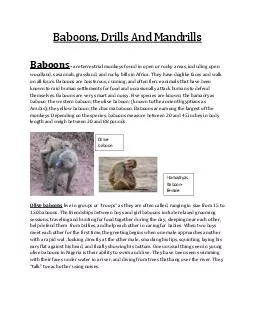PDF-Baboons Drills And Mandrills are terrestrial monkeys found in open or rocky areas including
Author : alida-meadow | Published Date : 2015-02-21
They have doglike faces and walk on all fours Baboons are boisterous cunning and often fierce animals that have been known to raid human settlements for food and
Presentation Embed Code
Download Presentation
Download Presentation The PPT/PDF document "Baboons Drills And Mandrills are terrest..." is the property of its rightful owner. Permission is granted to download and print the materials on this website for personal, non-commercial use only, and to display it on your personal computer provided you do not modify the materials and that you retain all copyright notices contained in the materials. By downloading content from our website, you accept the terms of this agreement.
Baboons Drills And Mandrills are terrestrial monkeys found in open or rocky areas including: Transcript
Download Rules Of Document
"Baboons Drills And Mandrills are terrestrial monkeys found in open or rocky areas including"The content belongs to its owner. You may download and print it for personal use, without modification, and keep all copyright notices. By downloading, you agree to these terms.
Related Documents














